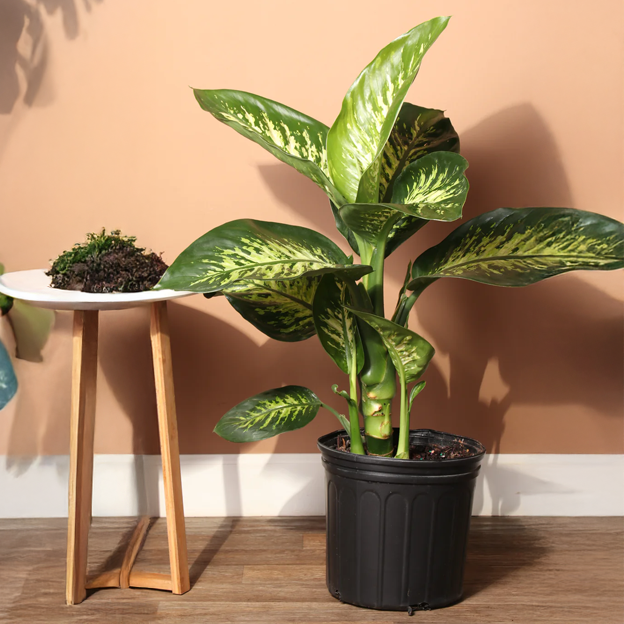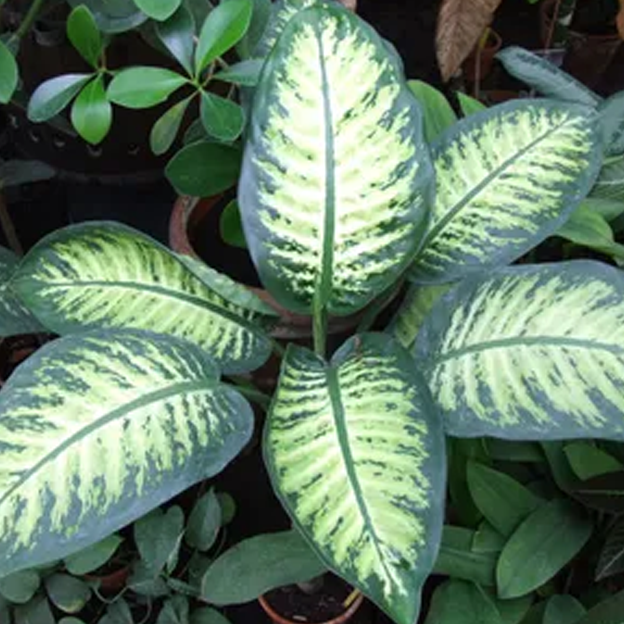Let me paint a picture for you: you walk into someone’s home and are instantly greeted by a positive space adorned with leafy greens thoughtfully placed around the house. That vibe just hits differently, doesn’t it?
One of my friends, who recently visited after her trip, complimented me on exactly that. I’ve placed a Dieffenbachia in the living room, and it seems like the plant is doing its job quite well! After talking about how eye-catching it looked, she was inspired to grow one too.
Highlighting this sweet little memory from just a week ago, I’ve decided to share a few tips and tricks for your Dieffenbachia or dumb cane plant care. This leafy green can beautify both indoor and outdoor gardens with its striking leaf colours, and it’s quickly becoming a favourite among home gardeners.
Now, grab your evening tea and take notes, because you’re about to become a little plant expert after reading this!
Dieffenbachia - The Striking Tropical Beauty
Known for its ovate-shaped leaves with creamy variegations and thick stems with ring-like patterns, Dieffenbachia has become quite popular among gardeners. Its striking appearance isn’t surprising, as it belongs to the famous Araceae family, which also includes beloved plants like Philodendron, Monstera, and Pothos. Plant enthusiasts may also know it by its unique names, such as Dumb Cane or Leopard Lily. If you’re searching for a plant that purifies indoor air, make sure to add this one to your list. It can grow anywhere between 3 to 7 feet tall indoors, giving your space that jungle-vibe makeover you adore so much.
Still hesitant about bringing this beauty home? Maybe you’re thinking, “What if it ends up looking meh, and I spoil yet another green?” Don’t worry, as I’ve got your back.
Care Tips For A Bigger and Healthier Dieffenbachia Plant
1. Sunlight Requirements
Dieffenbachia is a plant that thrives in bright sunlight, the kind that filters through your room window. That’s it, bright, indirect sunlight is its sweet spot! Avoid placing it in a shady or dark room, as you may slowly lose your plant. And when we’re talking about sunlight, let’s be clear: direct sunlight is also a big no. You might soon notice the plant’s vibrant colour fading.
2. Watering
Dieffenbachia likes to stay evenly moist, but not soaking wet (no one likes soggy feet, not even plants!). The best way is to check if the topmost layer of the soil is dry or not. While you're at it, make sure your planter has a drainage hole to avoid waterlogging.
3. Soil Mix
Well-draining soil is key to Dieffenbachia’s growth. You can prepare a mix using garden soil, neem khali, compost, and cocopeat. The plant prefers slightly acidic soil with a pH of 5.5 to 6.
4. Pruning
Trimming encourages bushier growth! Don’t be afraid to prune leggy stems or remove older, yellowing leaves. Regular pruning keeps the plant looking lush and tidy.
5. Fertiliser
Dieffenbachia is one of those forgiving plants that doesn’t demand much when it comes to nutrients. You can keep it happy by adding vermicompost once or twice every six months. That’s it!
6. Pests
Preventive measures go a long way here. Spraying neem oil on the leaves every few weeks can help protect your plant from common pests like mealybugs and spider mites. A healthy plant is a pest-resistant plant!
7. Propagation
One Dieffenbachia can easily turn into many more! Here's how:
- Stem Cuttings: Use sterilised scissors to cut the stem just above a node, ensuring the cutting has at least one or two leaves. Apply the rooting medium at the base of the cutting and place the cutting in either soil or water until roots develop.
- Root Division: While repotting, you might notice small offshoots at the ends of the roots. Gently separate them and pot them individually.

Benefits of Dieffenbachia Plant
Before buying the plant, I looked at the benefits, which made it one of the most suited plants for my interiors.
1. Air-Purifying Power
Dieffenbachia helps filter out the harmful chemicals that pollute the air, namely formaldehyde and xylene. You breathe into a space which feels fresher and healthier than before.
2. Low-Maintenance Plant
If you are searching for a perfect plant as a beginner, then don’t let its tropical looks fool you; Dieffenbachia can be your friend here. It is surprisingly easy to care for this plant. With a few care requirements, it will sit silently in the corner of your room without demanding constant attention. It can easily thrive in household conditions and can go a long way!
3. Make an aesthetic statement
The tropical jungle-like vibes reflect from every inch of the Dieffenbachia plant. Where you will not be able to get over its ovate, large, patterned leaves in vibrant shades of green and cream, the way your room will look after including this plant will turn you into a plant lover.
Yes, it’s the plant guests always notice and ask about.
4. Perfect for Indoor Spaces
When we said jungle vibes, it doesn’t necessarily mean giving more space in your room to the plant friends. Dieffenbachia grows tall and lush but doesn’t require much space. You can consider it as a great choice for filling up empty corners, placing beside sofas, or even jazzing up your hallway.
5. Mood-Booster
Personally, working with greenery around me fills me with energy and helps reduce stress. Studies have shown that indoor plants improve mood, lower stress levels, and boost productivity. Having a Dieffenbachia in your workspace or living area might just be the green pick-me-up you didn’t know you needed.
Plant Love Never Ends, but this blog does!
Here, I’ve shared the easiest tips to keep your Dieffenbachia looking healthy and happy. This leafy beauty is another great option to enhance your interiors in more ways than you can imagine. Now it’s your turn, let its vibrant leaves steal the spotlight and get ready to receive compliments on your plant love!
Urvann began as a simple idea to support home gardeners, and it has since grown into India’s most trusted marketplace for plants and gardening tools. Our well-cared-for plants have already reached thousands of homes across Delhi NCR and Bangalore.
If you loved reading this blog, drop a comment with a picture of your Dieffenbachia thriving after these tips! Also, tell us what plant care topics you'd love to read about next.
Frequently Asked Questions to Make Your Dieffenbachia Grow Bigger and Healthier!
-
How do you care for a Dieffenbachia plant indoors?
To care for your Dieffenbachia indoors, place the plant in a pot with well-draining soil, keep it somewhere it can receive indirect, filtered sunlight, and water the plant whenever the topmost layer of the soil appears dry.
-
What are the ways to make Dieffenbachia more bushy?
Pruning is key to making your Diefenbachia plant bushy! Trim leggy stems or tall shoots just above a leaf node (where leaves grow out from the stem). This encourages the plant to grow sideways instead of upwards, making it fuller and bushier.
-
Can we place Dieffenbachia in a big pot?
When it comes to choosing the right kind of pot, always go with something that can let the roots of the plant expand enough. A large pot will have uneven soil distribution as per the requirements of the plant, which can have an impact on the growth of the plant. So, while repotting, choose a pot that is 2 times bigger in size than the one it was placed in before.
-
What can we do to make our Dieffenbachia plant happier?
Dieffenbachia is a very forgiving plant with some basic care requirements. It can stay happy when it receives filtered sunlight and watering whenever the topmost soil of the plant appears dry. You can take a step forward and also fertilise the plant about once or twice a year. Do not forget to prevent it from mites and mealy bugs that can suck life out of the plant.
-
How can we revive a dying Dieffenbachia Plant?
To revive a dying dieffenbachia, keep it in indirect but bright sunlight. Make sure it receives the right amount of watering, as more of it can lead to root rot. If the leaves of the plant appear to be drooping, you can also repot the plant and check if the roots are looking rotten and snip them carefully. You can now choose a new pot and care for your plant there.


